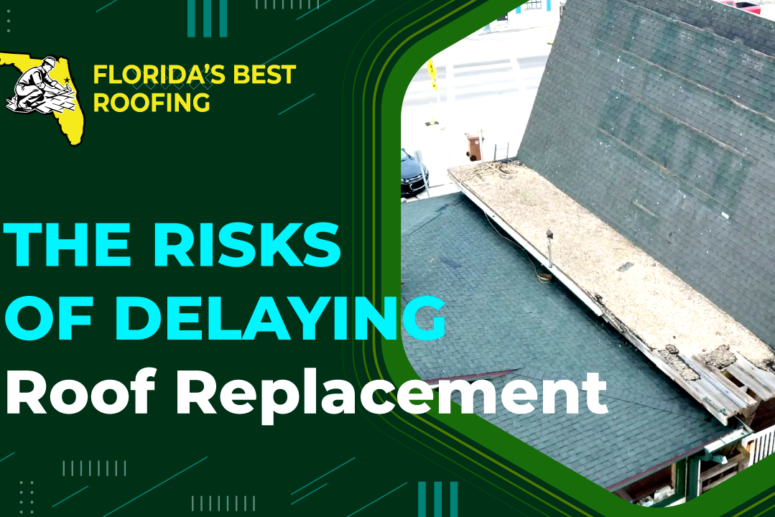Florida, known for its sunshine and pleasant climate, is a popular destination for residents and tourists alike. However, our beautiful state also faces unique weather challenges that can take a toll on its structures, especially roofs. The combination of intense heat, humidity, heavy rainfall, and the occasional hurricane makes Florida a demanding environment for roofs. In this post, we’ll explore the impact of Florida weather on roofs and discuss key factors homeowners should consider to protect their investment.
The Scorching Sun
Florida is renowned for its sunny weather, with plenty of days filled with relentless sunlight. While this is great for beachgoers, it can be harsh on roofs. Prolonged exposure to the sun’s ultraviolet (UV) rays can cause roofing materials to deteriorate over time. Asphalt shingles, for example, may become brittle, lose their flexibility, and develop cracks. To combat this, homeowners should invest in UV-resistant roofing materials and conduct regular inspections to catch damage early.
High Humidity
Florida’s tropical climate is characterized by high humidity levels, especially during the summer months. Humidity can promote the growth of mold and algae on roofs, leading to unsightly stains and potential damage. Regular cleaning and maintenance are essential to prevent these issues. Additionally, proper attic ventilation can help reduce moisture buildup, prolonging the life of your roof.
Heavy Rainfall
Florida experiences its fair share of heavy rainfall, particularly during the hurricane season. Roofs must be able to withstand torrential downpours without leaking or sustaining damage. Proper installation, regular inspections, and well-maintained gutters and drainage systems are crucial to prevent water infiltration and protect your home’s interior.
Hurricane Threats
Florida is no stranger to hurricanes, and these powerful storms can wreak havoc on roofs. High winds, flying debris, and driving rain can cause significant damage, from missing shingles to complete roof failure. To safeguard against hurricane-related roof damage, homeowners should consider impact-resistant roofing materials and ensure their roofs are properly anchored and inspected for weaknesses.
Salt Air and Coastal Living
Many Floridians enjoy coastal living, but the proximity to saltwater can be detrimental to roofs. The salt-laden air can corrode metal roofing components and accelerate the deterioration of other materials. Coastal homeowners should invest in materials that are resistant to saltwater corrosion and schedule regular roof inspections to catch any signs of damage early.
Thermal Expansion and Contraction
Florida’s climate can lead to significant temperature fluctuations, from scorching hot days to cool evenings. These temperature changes cause roofing materials to expand and contract, which can lead to stress and damage over time. Properly installed and well-maintained roofs should account for these fluctuations, but regular inspections are essential to identify any issues before they become serious.
The Importance of Roof Maintenance
Given the unique weather challenges that Florida presents for roofs, proactive maintenance is essential to maximize their lifespan and prevent costly repairs. Here are some tips for maintaining your Florida roof:
- Regular Inspections: Schedule annual roof inspections by a professional to identify and address issues early.
- Clean Gutters: Keep gutters and downspouts clear of debris to ensure proper drainage during heavy rain.
- Trim Overhanging Trees: Trim branches that could fall onto your roof during storms, preventing damage.
- Clean Moss and Algae: Remove moss, algae, and debris from your roof’s surface to prevent damage and improve aesthetics.
- Check Flashing: Ensure that roof flashing, which seals roof penetrations, is in good condition to prevent leaks.
- Repair Damage Promptly: If you notice any signs of roof damage, such as loose shingles or leaks, address them promptly to prevent further issues.
Conclusion
Florida’s diverse and sometimes extreme weather conditions can pose challenges for roofs, but with proper maintenance and consideration of the unique environmental factors, homeowners can protect their investment and ensure their homes remain safe and secure. Whether you’re dealing with the scorching sun, heavy rainfall, hurricane threats, or coastal living, proactive measures and regular inspections are key to a long-lasting roof in the Sunshine State. By taking these steps, you can enjoy the beauty of Florida without worrying about the impact of its weather on your home’s most important protective barrier.
If you have any questions about roofs or need a roof repair, we would be happy to help you out. Florida’s Best Roofing, Inc. is a fully licensed (CCC 1325974) and insured, local roofing contractor with decades of experience. If you are interested in roof replacement or repair and you are in the Palm Coast, Flagler, or Volusia area, please give us a call at 386-263-7906 for a free estimate!



